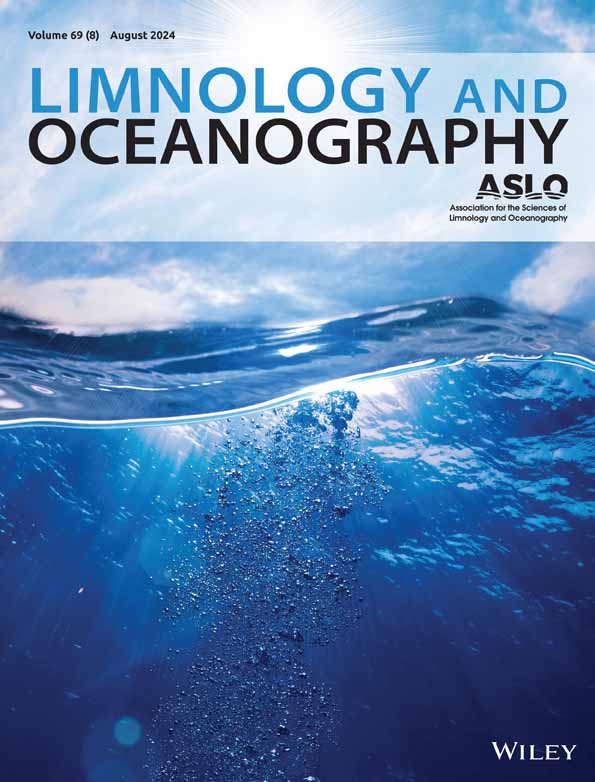铜和铁对两种南大洋硅藻生长和硅酸吸收的影响
IF 3.8
1区 地球科学
Q1 LIMNOLOGY
引用次数: 0
摘要
铜(Cu)和铁(Fe)是影响硅藻生理、生长速度和营养化学计量的重要微量营养素。本研究考察了铜和铁对两种南大洋硅藻——长鼻藻和弯曲毛藻在不同铁和铜条件下培养的相互作用效应。结果表明,随着Fe和Cu浓度的降低,Cu和Fe相互作用导致生长速率整体下降。铜缺乏抑制生长速度,表明铜在生化途径中的组成作用,特别是在铁限制条件下。铁和铜的变化也影响细胞体积(CV)和表面积(SA),在铁胁迫下,P. inermis的CV和SA增加。屈曲弧菌的CV和SA变化较大。铁和铜生物利用度的变化显著影响硅酸(Si(OH)4)的吸收,这反映在最大Si(OH)4吸收速率和Si(OH)4吸收的半饱和常数上。两种硅藻在Fe和Cu浓度变化下的Si同位素分异值在- 0.38‰±0.03‰至- 1.43‰±0.11‰之间,在C. flexuosus中为- 1.33‰±0.10‰至- 2.18‰±0.05‰之间。我们的研究结果证实,Cu和Fe的相互作用显著影响硅藻的形态和生理参数,特别是Si(OH)4亲和力和Si同位素分异。这项工作强调了进一步研究这些协同效应的必要性,因为它们可以影响硅藻生产,而硅藻生产反过来又可能影响南大洋的群落组成动态。本文章由计算机程序翻译,如有差异,请以英文原文为准。
Impact of copper and iron on growth and silicic acid uptake in two Southern Ocean diatoms
Copper (Cu) and iron (Fe) are vital micronutrients that influence diatom physiology, growth rate, and nutrient stoichiometry. This study examines the interactive effects of Cu and Fe on two Southern Ocean diatoms, Proboscia inermis and Chaetoceros flexuosus , cultured under varying Fe and Cu conditions. Results show that Cu and Fe interactions lead to an overall decline in growth rates with decreasing Fe and Cu concentrations. Cu deficiency inhibits growth rate, suggesting a constitutive role of Cu in biochemical pathways, especially under Fe‐limiting conditions. Changes in Fe and Cu also influenced cell volume (CV) and surface area (SA), with P. inermis showing an increased CV and SA under Fe stress. For C. flexuosus , changes in CV and SA were more variable. Changes in Fe and Cu bioavailability significantly affected silicic acid (Si(OH)4 ) uptake, as reflected in the maximum Si(OH)4 uptake rate and the half‐saturation constant for Si(OH)4 uptake. Both diatoms also displayed a wide range of Si isotope fractionation values, ranging from −0.38‰ ± 0.03‰ to −1.43‰ ± 0.11‰ in P. inermis and −1.33‰ ± 0.10‰ to −2.18‰ ± 0.05‰ in C. flexuosus under changing Fe and Cu concentrations. Our findings confirm that Cu and Fe interactions significantly affect morphological and physiological parameters in diatoms, particularly Si(OH)4 affinity and Si isotope fractionation. This work highlights the need for further investigation into these synergistic effects, as they can influence diatom production, which may, in turn, impact community composition dynamics in the Southern Ocean.
求助全文
通过发布文献求助,成功后即可免费获取论文全文。
去求助
来源期刊

Limnology and Oceanography
地学-海洋学
CiteScore
8.80
自引率
6.70%
发文量
254
审稿时长
3 months
期刊介绍:
Limnology and Oceanography (L&O; print ISSN 0024-3590, online ISSN 1939-5590) publishes original articles, including scholarly reviews, about all aspects of limnology and oceanography. The journal''s unifying theme is the understanding of aquatic systems. Submissions are judged on the originality of their data, interpretations, and ideas, and on the degree to which they can be generalized beyond the particular aquatic system examined. Laboratory and modeling studies must demonstrate relevance to field environments; typically this means that they are bolstered by substantial "real-world" data. Few purely theoretical or purely empirical papers are accepted for review.
 求助内容:
求助内容: 应助结果提醒方式:
应助结果提醒方式:


